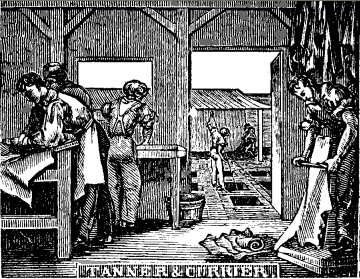Collecting Delaware Books
Delaware Leathermaking
First published April 1994

A book that unexpectedly supplies much information on Delaware history is Tanning in the United States to 1850 by Peter C. Welsh. It was published by the Smithsonian Institution, Washington, in 1964 as National Museum Bulletin 242. There was probably a paperback edition, but the copy before me is nicely bound in reddish brown cloth with gold stamped title and Smithsonian seal. It has pictorial endpapers depicting tannery workers at various tasks, taken from an 18th century engraving.
Tanneries were a common local industry in all parts of the country. The book describes processes and business practices generally for several chapters, then uses specific examples from the industry in Delaware.
Wilmington had a number of well-documented tanneries, however the craft was also practiced in Newport and Newark. The first industry of any kind in Middletown was tanning, and William Corbit (whose house still stands) had a tannery in Odessa. John and Alexander Peterson operated a tannery in Smyrna from 1782. It employed nine men paid an average of $15 per month.
In Kent County, there was a large tannery on the John Dickinson plantation. Thomas Clark operated a tannery in Frederica as early as 1792. Milford boasted a large bark chipping mill that served the industry. Sussex County listed 14 tanners in 1810.
The author devotes a whole chapter to the tannery operated by the du Pont interests as Cardon and Company at what is now the grounds of the Hagley Museum. This was a large, well-documented, and unusually scientific operation. E. I. du Pont sent for information, chemicals, and experts from France. As du Pont de Nemours said, what could be better than a tannery in a country where "nobody goes barefoot and nobody wears wooden shoes."
It was, however, the lack of scientific methods that caused the demise of small leather tanneries by 1850. In Delaware, Oliver Evans had automated flour milling, the Gilpins had built papermaking machines, Jacob Broom built water-powered textile mills, and the du Ponts had the most modern gunpowder manufactory in the world. The tanners were still processing one hide at a time in holes dug in the ground. Processing chemicals were uncontrolled substances like tree bark and dog feces.
The sequel to this book needs to be written. After 1850, Wilmington became a leathermaking center with large factories. The profession "Morocco worker" became common in city directories. Stories of the smell and unhealthy conditions emanating from these businesses are common in early 20th century Wilmington literature.
These factories were often owned by German immigrants and employed the more recently arrived Polish and Irish immigrants. There are still people alive who remember working in these factories and even more whose parents and grandparents did so. Lets hope someone soon records this part of our history before the personal knowledge is lost.